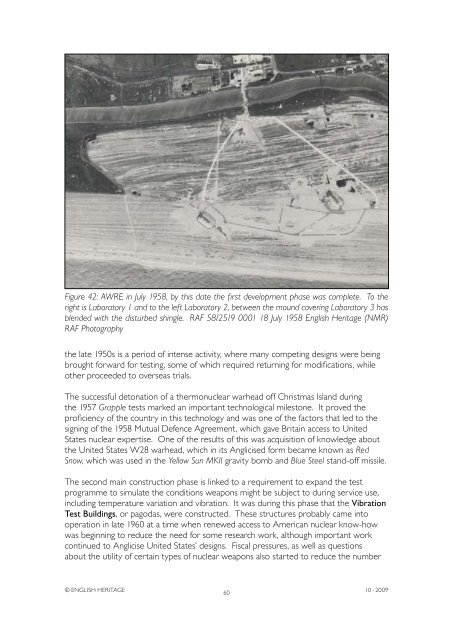Atomic Weapons Research Establishment. Orford ... - English Heritage
Atomic Weapons Research Establishment. Orford ... - English Heritage
Atomic Weapons Research Establishment. Orford ... - English Heritage
Create successful ePaper yourself
Turn your PDF publications into a flip-book with our unique Google optimized e-Paper software.
Figure 42: AWRE in July 1958, by this date the first development phase was complete. To the<br />
right is Laboratory 1 and to the left Laboratory 2, between the mound covering Laboratory 3 has<br />
blended with the disturbed shingle. RAF 58/2519 0001 18 July 1958 <strong>English</strong> <strong>Heritage</strong> (NMR)<br />
RAF Photography<br />
the late 1950s is a period of intense activity, where many competing designs were being<br />
brought forward for testing, some of which required returning for modifications, while<br />
other proceeded to overseas trials.<br />
The successful detonation of a thermonuclear warhead off Christmas Island during<br />
the 1957 Grapple tests marked an important technological milestone. It proved the<br />
proficiency of the country in this technology and was one of the factors that led to the<br />
signing of the 1958 Mutual Defence Agreement, which gave Britain access to United<br />
States nuclear expertise. One of the results of this was acquisition of knowledge about<br />
the United States W28 warhead, which in its Anglicised form became known as Red<br />
Snow, which was used in the Yellow Sun MKII gravity bomb and Blue Steel stand-off missile.<br />
The second main construction phase is linked to a requirement to expand the test<br />
programme to simulate the conditions weapons might be subject to during service use,<br />
including temperature variation and vibration. It was during this phase that the Vibration<br />
Test Buildings, or pagodas, were constructed. These structures probably came into<br />
operation in late 1960 at a time when renewed access to American nuclear know-how<br />
was beginning to reduce the need for some research work, although important work<br />
continued to Anglicise United States’ designs. Fiscal pressures, as well as questions<br />
about the utility of certain types of nuclear weapons also started to reduce the number<br />
© ENGLISH HERITAGE<br />
60<br />
10 - 2009

















